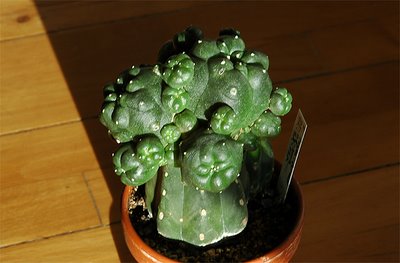Two years ago I grafted a 2 cm (~0.8'') wide Lophophora williamsii v. caespitosa cutting on a Trichocereus bridgesii stock. The main head has now grown to a width of 5.5 cm (~2.2'') and the total width of the scion exceeds 10.5 cm (~4.1'') – unfortunately the plant hasn’t flowered yet.

Grafted Lophophora williamsii v. caespitosa
I’ve given up keeping count of the number of offshoots; the plant is virtually exploding with growth.
Trichocereus bridgesii is an exemplary stock plant; it’s long-lived, fast growing, not offsetting and almost spineless.
Last year I also posted a picture of the – then much smaller – Lophophora williamsii v. caespitosa graft. A photo of the flowering plant can be found in this post.
Malpighia 1927 v.30 (added: 11/24/2025)
-
*By:*
Borzi, Antonino,1852-1921.
Penzig, O.1856-1929.
Pirotta, Romualdo,1853-1936.
*Publication Info:*
Messina : g. Capra & co., 1887-89 ; Genova : Tip. di A...
1 month ago



















That's looking nicely. I have a few Caespitose Lophs, and I never like the fact that they seem to have buttons coming out of all sorts of odd places (often looking more like some mutant experiment than a cactus). I have tried planting them deeper and covering with pebbles, and the lower buttons usually grow taller quite quickly, making the plant look more like a regular clump (which I prefer).
ReplyDeleteI was wondering about the difference between highly caespitose specimens and normal offsetting ones, and I wonder if the main difference is that caespitosas produce pups through the roots and through the areoles, while offsetting ones only do so through the roots. Does this seem plausible to you?
Keep on posting!
-Yair
Beautiful plant
ReplyDeleteBut I must question your identification of the stock. Looks much more like a T. pachanoi than a bridgesii. I have never seen bridgesii with such small spines.
Yair, my “normal” Lophophora also produce offsets from the areoles – especially if grafted (an example can be seen at http://lophophora.blogspot.com/2006/04/power-of-grafting-ix-full-circle.html). I think the main difference between the caespitose and normal forms is the inclination to tiller; the normal form offsets quite reluctantly while the caespitose form does it freely.
ReplyDeleteIndole, the plant from which I obtained the cutting used as stock has almost 5 meters (~5 yards) tall pale green stems and very long spines on old growth (and was labeled Trichocereus bridgesii ;-). I expect the stock to grow more spines as it matures; but you’re right the plant in its current form looks like a Trichocereus pachanoi (and might well be, given the confusion surrounding Trichocereus taxonomy).
I have a questions..
ReplyDeleteMy plant was given to me shriveled up black and soaking wet.. so i dried it for a few days, and just snipped the top of the button off, the insides are still a miniscuel hint of green, mostly yellows and oranges, but still wet and moist inside. should i continue drying? or plant it and hope for the best, i couldnt not graft the top because it was shrivveld and black.
MY plany isnt dead right?
Sol, based on your description it seems like your plant is in dire straits. If it's discolored and mushy inside with only a hint of green I think it's probably beyond salvage. In case of rotting plants, I cut away all parts that are not green and turgid and let the remaining plant dry for some days before rooting it, but I have to say that my results are not comforting (most plants subjected to this treatment ended up dead).
ReplyDeleteDo you have any photos of the plant? You can post a description of your problem with photos attached at the Google group http://groups.google.com/group/lophophora.
Great site brah. Can you confirm first (or second) hand if caespitosa is active in the same respect as L. Willi.?
ReplyDeleteHabermann made a comparative study of the alkaloid content of different Lophophora species/varieties. I don't have a copy of the original paper but the results are reproduced in Dr. Roman Štarha's appendix on Lophophora chemistry appearing in Rudolf Grym's book Rod/Die Gattung Lophophora.
ReplyDeleteHabermann found all varieties of williamsii (including caespitosa) to contain approximately 0.7 milligrams (mg) of mescaline per gram (g) of living plants (i.e. not dehydrated plant material), so according to this study the mescaline (and pellotine) content of var. caespitosa is comparable to any other variety of williamsii. How (or if) the absolute mescaline content is affected by grafting I don't know. But a grafted plant will be faster growing and "pumped up" compared to a non-grafted plant, which probably means that the relative alkaloid content measured in milligrams of alkaloid per gram of living plant will be lower for a grafted specimen. This is just conjecture, though.
I have read from a couple sources, one being Peyote And Psychoactive Cacti; that a grafted plants alkaloid content cannot keep up with such rapid growth, so you either need to re-root it after its large, then let it stabilize on its own roots for a year or two for the alkaloids to catch up to the size. Or cut it from the graft stock and let it hang out in a dark place for several months without water or anything to get stronger, similar to how some cut san pedros and let them chill and fast to get stronger before use.
ReplyDelete